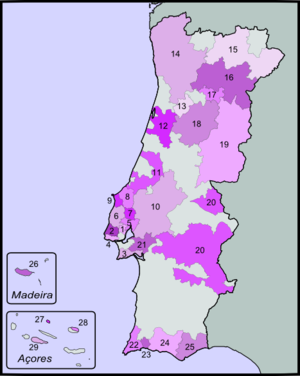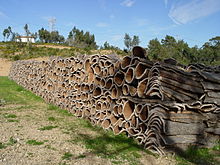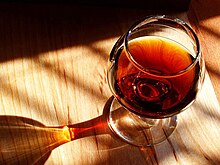Viticulture in Portugal
The viticulture in Portugal is full of contradictions. While heavy, tannin-rich red wines as well as Port and Madeira wine predominate in the interior, the cool Atlantic climate of the north produces light wines such as Vinho Verde .
history
In mythology, Lusus was the son or companion of the wine god Bacchus (Greek Dionysus). The Roman province of Lusitania , identical to parts of what is now Portugal, may have got its name from this mythological figure.
Phoenicians , Greeks and Romans brought the vines and viticulture to Portugal , which was continued on a modest level during the Moorish rule. Since the 12th century, the Cistercian order founded 18 monasteries in Portugal and had a lasting influence on viticulture. King Dom Dinis (dt. King Dionysius, the sixth king of Portugal from the House of Burgundy ), called the "peasant king", promoted agriculture and viticulture so decisively that a merchant fleet could be built with the income and thus the basis for the Rise to world power was created.
After the Battle of Aljubarrota / Alcobaça in 1385 and the Treaty of Windsor (1386) , there was a flourishing wine trade with Great Britain . Under Henry the Navigator , Muscat and Malvasia grapes were planted on the rediscovered island of Madeira . After the levying of high duties on French wines by William III. In 1693, English wine merchants discovered Portuguese red wine as an alternative. The port wine and Madeira were the major export it. In 1756 Portugal passed the world's first law to limit a growing area , the Alto Douro port wine region on the Douro . The destruction of the growing areas by powdery mildew and phylloxera threw wine production back until around 1930 a rebuilding by numerous winegrowers' cooperatives began. The Carnation Revolution and the opening up to the European Community finally ensured a renaissance of Portuguese viticulture. The internationally best-known product has long been Mateus Rosé, which is mass- produced .
Facts
In Portugal, a vineyard area of around 239,000 hectares (the seventh largest in the world in terms of area) is cultivated , which results in an annual production of around 6 - 7 million hectoliters . In the ranking of global annual production, Portugal is just behind Germany in 11th place. In the last 5 years, Portugal has been able to increase its annual production by 8 percent, contrary to the global trend, and has achieved some successes, especially in exports. Around 15% of the working population in Portugal make a living from viticulture. The annual wine consumption is 42 - 43 liters per capita, which is less than that of Luxembourgers and French people. The first place among the wine-drinking countries with 130 liters per capita consumption, as rumored in some older publications, has long been lost.
Today there are five wine-growing zones in Portugal with over 40 quality wine-growing areas, 26 of which have DOC status. DOC means Denominação de Origem Controlada in Portugal and corresponds to the Spanish DO or the French AOC system. Six regions produce IPR wines ( Indicação de Proveniencia Regulamentada , corresponding to the VDQS wines), eight regions produce country wines ( Vinhos Regionais , corresponding to the French Vin de Pays ). The rest is table wine ( Vinho de Mesa ).
Portugal has a large variety of indigenous white and red grape varieties . With the Colares one also has one of the extremely rare wines that are still grown with real European vines ( Ramisco ) in the sand north of Sintra in Colares near the Atlantic coast. The phylloxera, which destroyed almost all other European vines in the 19th century, could not survive in the sand.
Wine names
The wineries are called Quintas (Portuguese for country estate ), comparable to the French term propriété . Wineries are called caves .
- Verdes : young wines that can be consumed quickly
- Maduro : mature wines
- Garrafeira : top wines aged for a long time
Grape varieties
Due to its climatic, geological and topographical diversity, Portugal has over 500 autochthonous grape varieties, the so-called Castas . Currently (as of 2013) 341 varieties are permitted for wine production. The most important red wine varieties are Alfrocheiro , Tinta Roriz , Baga , Castelão Francês , Touriga Francesca and Touriga Nacional . The most important white wine varieties are Alvarinho , Arinto , Avesso , Azal , Bical , Encruzado , Loureiro , Trajadura and Verdelho .
White wine varieties
|
|
Red wine varieties
Growing areas

- Vinho Verde
- In the cool, rainy and fertile north of Portugal, fresh, quickly consumed wines (Vinho Verde) grow on barren, sandy granite soils . In addition to the well-known white varieties, there are also local red varieties that are very tannic.
- Douro
- The port wine growing area east of Porto on the Douro River. The slate soils store moisture and help the vines survive the dry and hot summers. In the meantime, classic red wines of remarkable quality are increasingly coming from the Douro , slightly less tannic and more acidic than from other regions.
- Bairrada
- Growing area around the city of Águeda . Heavy red wines from the Baga grape are produced here.
- Dão
- The traditional wine-growing region of the Dão is located in the mountainous Beira region, north of the highest mountains in Portugal, the Serra da Estrela , and is also crossed by the Buçaco and Caramulo mountains - for this reason, the vineyards are typically terraced. The area is named after the river of the same name that flows through it. The most important grape varieties are Tourigo, Tinta Pinheira and Alvarelhão for red wine, Arinto, D. Branca and Barcelos for white wine.
- Extremadura
- Coastal strip near Lisbon with an Atlantic climate and often sandy soils. The wines are fresh and modern.
- Terras do Sado
- The Palmela and Setúbal regions . Dry white wines, classic red wines and muscatel are produced. The best-known muscatel from the Setúbal region is the Moscatel Roxo , which only comes onto the market after 20 years of cellar maturation.
- Alentejo
- The hot climate favors the production of modern top-quality wines. The quality of the red wines is consistently impressive, with the white wines the chilled processing is decisive for the quality.
- Madeira
- The Atlantic island with its tropical climate is famous for its Madeira varieties .
- Azores
- Viticulture is carried out on the islands of Graciosa , Pico and Terceira (DOC areas Pico, Biscoito (Terceira) and Graciosa). Viticulture on Pico is recognized as a UNESCO World Heritage Site as a viticulture cultural landscape on the island of Pico .
- Tejo (formerly Ribatejo)
- The central agricultural center in Portugal has very good mineral soils, which are often interspersed with gravel, and benefits from its location on the Tagus River . The climate is mild all year round.
Cork production

Portugal ranks first among the cork producers worldwide, it owns 31% of the cork oak stocks . 190,000 tons of corks (51% of world production) are harvested in Portugal.
literature
- Jancis Robinson : The Oxford Wine Lexicon, 3rd revised edition . 1st edition. Hallwag, Gräfe and Unzer Verlag, Munich 2007, ISBN 978-3-8338-0691-9 .
- Wolfgang Hubert, David Black Forest: Portugal and its wines . 2nd Edition. Hallwag, Gräfe and Unzer Verlag, Munich 2008, ISBN 978-3-8338-0641-4 .
- AJM Silva: (19) Les vins au goût d'argile: anatomie d'une tradition plurimillénaire. Le cas d'étude portugais du vin de talha . 138e Congrès des Sociétés Historiques et Scientifiques: Se nourrir, pratiques et stratégies alimentaires (Rennes, April 22-26, 2013), Éditions SHS, Rennes 2014, academia.edu .
Web links
- Information about Portuguese wines and the cultivation areas (English)
- ViniPortugal (English, Portuguese)
- Viticulture in Madeira (German)
Individual evidence
- ↑ a b A. JM Silva: (19) Les vins au goût d'argile: anatomie d'une tradition plurimillénaire. Le cas d'étude portugais du vin de talha . 138e Congrès des Sociétés Historiques et Scientifiques: Se nourrir, pratiques et stratégies alimentaires (Rennes, April 22-26, 2013), Éditions SHS, Rennes 2014, academia.edu
- ↑ OIV report from 2013. ( Memento from August 18, 2013 in the Internet Archive ) (PDF)

